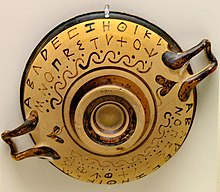Chi (letter)
 | ||||||||||||||||||||||||||||||||||||||||||||||||
| Greek alphabet | ||||||||||||||||||||||||||||||||||||||||||||||||
|---|---|---|---|---|---|---|---|---|---|---|---|---|---|---|---|---|---|---|---|---|---|---|---|---|---|---|---|---|---|---|---|---|---|---|---|---|---|---|---|---|---|---|---|---|---|---|---|---|
|
||||||||||||||||||||||||||||||||||||||||||||||||
| History | ||||||||||||||||||||||||||||||||||||||||||||||||
| Use in other languages | ||||||||||||||||||||||||||||||||||||||||||||||||
| Related topics | ||||||||||||||||||||||||||||||||||||||||||||||||
Chi (uppercase Χ, lowercase χ; Greek: χῖ) is the 22nd letter of the Greek alphabet, pronounced as /kaɪ/ in English.
Greek

Pronunciation
Ancient Greek
Its value in Ancient Greek was an aspirated velar stop /kʰ/ (in the Western Greek alphabet: /ks/).
Koine Greek
In Koine Greek and later dialects it became a fricative along with Θ and Φ.
Modern Greek
In Modern Greek, it has two distinct pronunciations: In front of high or front vowels (/e/ or /i/) it is pronounced as a voiceless palatal fricative [ç], as in German ich or like the h in some pronunciations of the English words hew and human. In front of low or back vowels (/a/, /o/ or /u/) and consonants, it is pronounced as a voiceless velar fricative ([x]), as in German ach. Chi is Romanized as <ch> in most systematic transliteration conventions, but also sometimes as <h> or <x> in informal practice.
Greek numeral
In the system of Greek numerals, it has a value of 600.
Xi
In ancient times, some local forms of the Greek alphabet used the chi instead of xi to represent the /ks/ sound. This was borrowed into the early Latin language, which led to the letter X being used for the same sound in Latin, and the modern languages which use the Latin alphabet.
Cyrillic
Chi was also included in the Cyrillic script as the letter Х, with the phonetic value /x/ or /h/.
International Phonetic Alphabet
In the International Phonetic Alphabet, chi is the symbol for the voiceless uvular fricative.
Chiasmus
Chi is the basis for the name Chiastic structure and the name of Chiasmus.
Symbolism
In Plato's Timaeus, it is explained that the two bands which form the soul of the world cross each other like the letter Χ.
Chi or X is often used to abbreviate the name Christ, as in the holiday Christmas (Xmas). When fused within a single typespace with the Greek letter Rho, it is called the labarum and used to represent the person of Jesus Christ.
Computer encoding
Uppercase and lowercase Greek chi are represented in Unicode as U+0397 (Χ) and U+03C7 (χ) respectively. For a table of accented Greek characters, see Greek diacritics: Computer encoding.
Math and science
In statistics, the term chi-squared or has various uses, including the chi-squared distribution, the chi-squared test, and chi-squared target models.
In algebraic topology, Chi is used to represent the Euler characteristic of a surface.
In neurology, the optic chiasm is named for the letter Chi because of its Χ-shape.[1]
In chemistry, the mole fraction may be denoted by the lowercase .[2][3]
In rhetoric, both chiastic structure (a literary device) and the figure of speech Chiasmus derive from their names from the shape of the letter Chi.
In engineering, chi is used as a symbol for the reduction factor of relevant buckling loads in the EN 1993, a European Standard for the design of steel structures.
References
- ^ Asimov, Isaac (1963). The Human Brain. Boston: Houghton Mifflin.
- ^ Zumdahl, Steven S. (2008). Chemistry (8th ed. ed.). Cengage Learning. p. 201. ISBN 0547125321.
{{cite book}}:|edition=has extra text (help); More than one of|pages=and|page=specified (help) - ^ Rickard, James N. Spencer, George M. Bodner, Lyman H. (2010). Chemistry : structure and dynamics (5th ed. ed.). Hoboken, N.J.: Wiley. p. 357. ISBN 9780470587119.
{{cite book}}:|edition=has extra text (help); More than one of|pages=and|page=specified (help)CS1 maint: multiple names: authors list (link)


